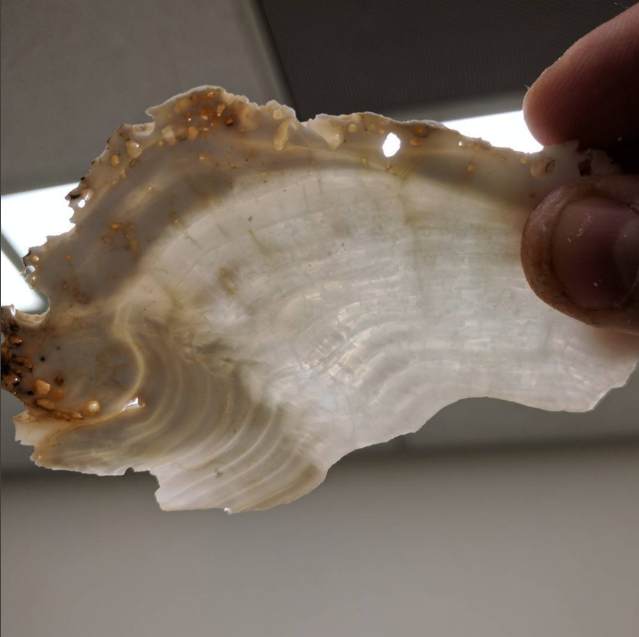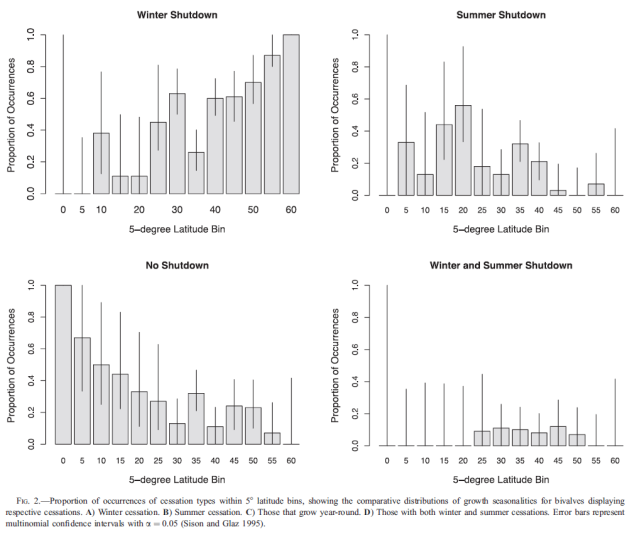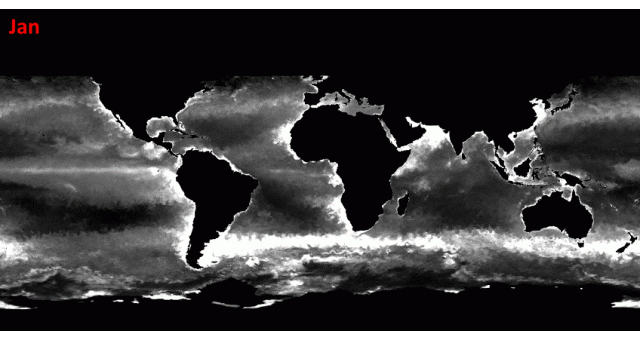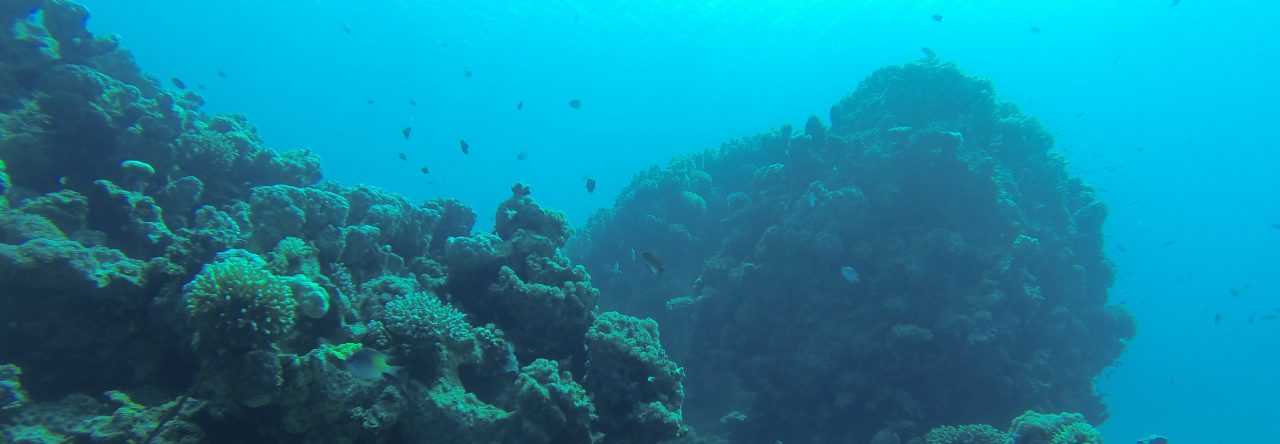My latest clamuscript is published in Palaios, coauthored with my advisor Matthew Clapham! It’s the first chapter of my PhD thesis, and it’s titled “Identifying the Ticks of Bivalve Shell Clocks: Seasonal Growth in Relation to Temperature and Food Supply.” I thought I’d write a quick post describing why I tackled this project, what I did, what I found out, and what I think it means! Raw unformatted PDF of it here on my publication page.
Why I did this project:
I study the growth bands of bivalve (“clam”) shells. Bivalves create light and dark shell growth bands as they grow their shells, much like the rings of a tree. The light bands form during happy times for the clam, when it is growing quickly and putting down lots of carbonate. The dark bands appear during times of cessation, when the bivalve ceases growth during a hibernation-like period. This can happen in the cold months, or the hot months, or both, or neither, depending on the clam and where it lives. It turns out that there are a lot of potential explanations for why these annual cessations of growth happen. Different researchers have suggested through the years that temperature (high or low) is the biggest control on the seasons that bivalves grow, but others have suggested that food supply is more important. Others say it’s mostly a function of the season they reproduce, when they’re putting most of their energy into making sperm/eggs and not growing their bodies. I wanted to try to see if I could find trends across all of bivalves which would shed light on which factors are important in determining their season of growth.

What I did:
I read a ton of papers in the historical literature about bivalves. These were written by people in many fields: aquaculture, marine ecology, paleoclimate researchers (using the clams shells as a chemical record of temperature), and more. All of the papers were united by describing the seasons that the bivalves grew, and the seasons that they stopped growing. I ended up with nearly 300 observations of marine (saltwater) bivalve growth for dozens of species from all around the world. I had papers as old as the earliest 1910s, and some as new as last year.

We have mussels, oysters, scallops, clams, cockles, geoducks, giant clams, razor clams, quahogs, and more in the database. Bivalves that burrow. Bivalves that sit on the surface of the sediment. Bivalves that stick onto rocks. Bivalves that can swim. With each, I noted data that the researchers recorded. If they grew during a season, I coded it as a 1. If they didn’t, I coded it as a 0. So a bivalve growing in summer but not winter would be recorded as 1,0. I also recorded environmental data including temperature of the location in winter and summer in the location, as well as seasonal supply of chlorophyll (a measure of phytoplankton, which is the main source of food for most clams). It turned out that not enough of the studies recorded temperature or chlorophyll for their sites, so I wanted to back these up with an additional data source. I downloaded satellite-based temperature and chlorophyll data for each location, as well as additional studies which directly measured chlorophyll at each site. I wanted lots of redundant environmental data to ensure that any trend or lack of trend I observed in my analysis was not due to a weakness of the data.
I then compared the occurrence of shutdown by season with these environmental variables using a statistical technique called regression. Regression basically involves trying to relate a predictor variable (in this case, latitude, temperature and chlorophyll during a certain season) to the response variable (did the clam grow in that season or not?). We wanted to see which environmental variable relates most closely to whether or not the clam grows or not. Because our dependent variable was binary (0 or 1), we used a technique called logistic regression, which tries to model the “log odds” of an event occurring in response to the predictor variable. That log odds can then be back-calculated to probability of the event occurring.
What we found:

In a clamshell, we found that latitude (distance from the equator) is a very good predictor of whether or not a bivalve shuts down for the winter. As you’d expect, bivalves in the far north and far south of our planet are more likely to take a winter nap. However, bivalves at the equator mostly grow year round and are not likely to take a summer nap. In relation to temperature, the lower the winter temperature, the more likely the bivalve is to stop shell growth. High summer temperature is not as good a predictor for the occurrence of a summer shutdown, but the majority of summer shutdowns seem to occur at the low temperate latitudes, where the difference between the annual range of temperature is largest. Unlike at the equator, where bivalves likely can adapt to the hottest temperatures and be happy clams, they have to adapt to a huge range of temperatures in places like the American Gulf and Atlantic coasts, the Adriatic and Gulf of California. And if they are restricted at the northward end of their range, they may have no choice but to shut down in summer as there is nowhere cooler to migrate to.

Food supply, on the other hand, is not a good predictor of when bivalves shut down. When we went into this project, we expected food to be a powerful control on seasonal growth because it is intuitive and well understood that the better fed a bivalve is, the larger it will grow overall. But the seasonal low amount of chlorophyll (and therefore the amount of photosynthesizing plankton) in the bivalves’ areas had no relationship to whether or not the bivalve shut down in a certain season. To double check that this wasn’t a weakness in my satellite data, I downloaded additional direct observations from the same places as many bivalve studies in the dataset, but I still couldn’t find the relationship. We propose that the seasonal supply of phytoplankton is not well related to seasonal growth of bivalves because: 1) phytoplankton supply isn’t very seasonal in nature in most of the sites we studied. There are peaks in multiple seasons rather than a clean up and down wave shape like temperature. 2) Bivalves are pretty flexible in what they eat. They also eat other types of plankton and suspended particles that are even less seasonal. It may be pretty difficult to find bivalves that are seasonally starving. One of the most probable places to find such starvation shutdowns might be the poles, where seasonal ranges of temperature are quite small but plankton does really have a seasonal pattern of availability. More research will be needed to describe the nature of polar bivalves and why they shut down growth.
What’s next?
This is the first chapter of my PhD. I have two more chapters I’m working on, both related to the geochemistry of bivalve shells. I am writing those manuscripts this summer and looking for postdoctoral fellowships in the fall related to geochemistry of marine organisms in the fossil record. I hope to pursue more projects looking at the season of growth in bivalves, switching to understanding the role that changing seasonal cycles in their environment and biology play in their evolution. Do bivalves that live closer together tend to reproduce at different times? Can we track season of reproduction in relation to temperature and food supply? There are a lot more clam stories to be told and I look forward to sharing them all with you. Until the next research blog,
Dan

Pingback: Research Explainer: How giant clams record their diet in their shells – Clamsplaining